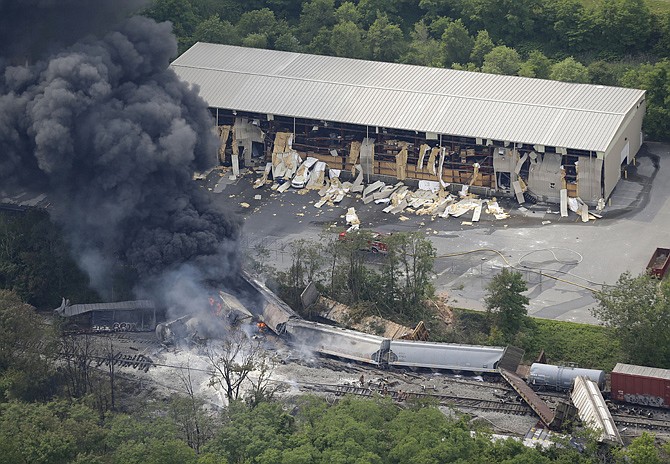ROSEDALE, Md. (AP) - Train operator CSX Transportation on Wednesday pointed to a hazardous chemical in a rail car as the source of an explosion on a derailed train near Baltimore that sparked a fire, rattled homes and damaged buildings. A company spokesman said officials still weren't sure what caused the sodium chlorate to explode in the first place, but it ignited another chemical in a second car.
Robert Sumwalt, a member of the National Transportation Safety Board, said investigators were examining evidence on the scene and reviewing train video that shows the collision with a garbage truck led to the derailment and the ensuing fire and explosion.
On Wednesday afternoon, workers were using heavy cranes to move the damaged rail cars, and an excavator was picking up broken pieces of track. The mangled truck lay on its side on the side of the railroad tracks, its contents littering the ground. Next to the track, the corrugated metal walls of a warehouse were bent and warped.
Sumwalt said at a news conference Wednesday that the freight train was traveling 49 mph and that the engineer blew a whistle three times before it collided with the truck around 2 p.m. Tuesday. The whistle on the locomotive was first blown 17 seconds before the collision, Sumwalt said, and it was sounding at the moment of impact.
Surveillance video and a camera mounted on the locomotive show that the garbage truck drove onto the tracks 3 seconds before it was struck. The truck was moving when the train collided with its right rear axle, officials said.
The train driver applied the emergency brakes, and the locomotive came to rest nearly a mile from the collision site, Sumwalt said. Smoke was visible 33 seconds after the collision, and flames were seen 10 seconds after that. But it was more than 5 minutes after the collision that the explosion occurred.
There is dense foliage on either side of the crossing, which is marked with signs but no flashing lights or moving barriers. Sumwalt said investigators would be looking into whether there were any obstructions that limited visibility for drivers using the crossing.
Of the 45 cars on the train, 14 were loaded and 31 were empty. Four were carrying hazardous materials, and of those, three derailed, Sumwalt said.
The chemical that first exploded, sodium chlorate, is highly volatile. The sodium chlorate was in powder form and was being hauled in a covered hopper car. Another chemical burned for nearly 10 hours after the crash.
CSX spokesman Gary Sease said the sodium chlorate was in a derailed car near the front of the train; the blast ignited terephthalic acid in another derailed car.
Among the buildings that sustained the most damage was a training facility for a plumbers and steamfitters union a few hundred yards away from the explosion site. Only a handful of employees were in the building at the time of the blast, and all but one rushed outside to see what had happened. They heard the crash first, followed by the derailment, then saw a plume of smoke.
Sumwalt said late Tuesday that the collision occurred at a private crossing where the only marking was a stop sign, but he backtracked at a news conference Wednesday, saying the crossing was registered with the government and that the agency had to determine whether or not it was private.
The truck driver was hauling a load from his company's office near the tracks to a location in Baltimore about 6 miles away, the NTSB said. The driver has used that crossing frequently, Sumwalt said.
The driver, 50-year-old John J. Alban Jr., remained in serious condition Wednesday at Shock Trauma in Baltimore, a hospital spokeswoman said. Two CSX workers aboard weren't hurt.

